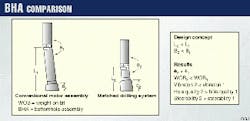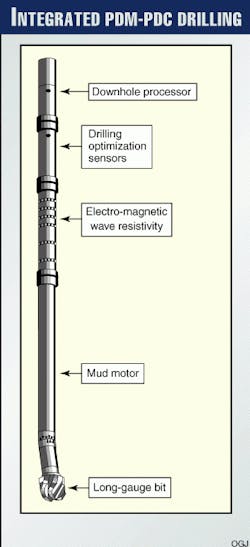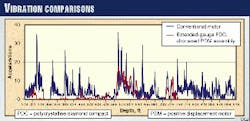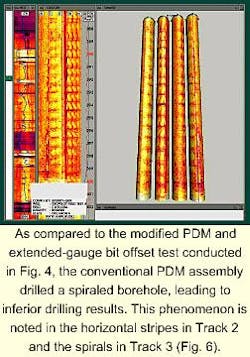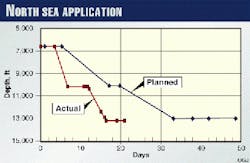A new steerable drilling system, which integrates a pin-down positive displacement motor (PDM) with a box-up, extended-gauge polycrystalline diamond compact (PDC) bit, has reduced bend angles and downhole vibrations leading to improved directional control and reduced hole spiraling.
Although widely recognized for providing excellent "gun-barrel" hole quality in vertical wells, directional engineers and drillers do not commonly combine extended-gauge bits with PDM assemblies, believing each component is incompatible with the other.
As a result, efforts have been undertaken to produce a system that retains the attributes of the steerable motor, such as directional control, while providing the hole-quality benefits of extended-gauge bit utilization.
Field applications and controlled testing now show that such a system can be used to turn, build, drop, and hold angle, much like a standard steerable assembly. Other benefits include improved hole-cleaning effects, reduced drag and hole tortuosity, and greater mud-motor (PDM) and measurement-while-drilling (MWD) tool reliability.
The improved overall hole quality led to increased penetration rates in both sliding and rotary modes, while reducing the time required for many nondrilling activities such as casing installation, hole conditioning, and back-reaming. The technology may also have considerable implications for extended-reach and coiled-tubing drilling applications.
Matched-drilling system
By treating the bit and motor as a system, it became possible to overcome directional limitations previously experienced when long-gauge bits, or short-gauge bits with piggyback stabilization, were used in combination with conventional motors.
Based on standard bit-selection criteria for local applications, the new steerable system utilizes a PDC bit design based on two criteria.
First, a nonaggressive cutting structure, typified by small, densely positioned cutters with high back-rake angles, improves steerability. Second, the bit's extended-gauge design acts as a long-gauge stabilizer (Fig. 1), providing a smoother wellbore by eliminating spiralling and ledging.
Consequently, because the pin-down mud motor incorporates a specifically designed bearing pack and shaft, it reduces the bend angle of the mud motor when matched with the long-gauge bit, without compromising directional performance (Fig. 2).
Typically, drillers run the bottomhole assembly (BHA) with a standard logging-while-drilling system. However, selective drilling optimization sensors are often recommended, including pressure-while-drilling, vibration, and MWD caliper sensors (Fig. 3).
In this way, drillstring optimization sensors can be used to validate information on hole cleaning, BHA vibration, and borehole quality.
Vibration reduction
Downhole vibration induced through BHA and bit whirl, a recognized cause of tool failure, is often addressed as part of the well planning process. Thus, it can influence BHA design and subsequent use of specific vibration-monitoring equipment.1
Additionally, engineers have investigated long-gauge bit design for its recognized stability and low side-cutting capacity. Side cutting tends to "gear" the bit to the wellbore, promoting the onset of bit whirl or bit walk.2 3
In terms of hole quality, a whirling bit compromises the wellbore on every revolution by failing to rotate about a true center. In a related process, hole spiraling also occurs when the bit center proceeds in a circular motion while the cutting structure moves forward. That is, only when the cutter-walk tendency or side-cutting motion is prevented, does the bit rotate truly.
In addition to the prevention of spiraling, the long-gauge bit itself tends to be stabilized, thus providing a higher-quality borehole. By comparison, stabilizing the mud motor or BHA still allows the bit to wobble, which can result in borehole tortuosity, spiraling, or overgauged well bores.
Bend distance
Another key principle of the matched-drilling system includes the reduced bit-to-motor bend distance, which provides improved steerability, torque-and-drag, and stability characteristics.
The mud motor contains a specially designed bearing pack and pin-down drive shaft that, when matched with a box-end bit, reduces the bit-to-motor bend distance in the new system by several feet shorter as compared to conventional PDM systems.
This reduction in length not only improves the steerability and weight transfer from the surface to the bit but also stabilizes the BHA by keeping the bent housing from contacting the wellbore wall.
Comparison of holes drilled by conventional PDMs and the matched-drilling system indicates that conventional PDM systems become prone to hole spiraling, whereas the matched-drilling system does not. This holds true in both rotary and oriented motor applications.
In back-to-back runs made in the same formations but in different wells, drillers ran both conventional PDM and matched-drilling BHAs through multiple formations.
From this work, drilling-and-logging data revealed that the new steerable system produced lower vibrations and improved borehole quality as compared to short-gauge bits. Hole spiraling was evident in both the sand and shale sections of the conventionally drilled wellbore.
Testing
To validate the concept, developed by Sperry-Sun and SecurityDBS as the SlickBore system, five matched-drilling BHAs and one conventional PDM system were tested in three deviated wells at the Gas Research Institute's test facility in Catoosa, Okla.
In each well-incorporating identical well plans-MWD directional, gamma ray, and downhole vibration data were provided. Additionally, engineers obtained wireline data for directional, caliper, and borehole-quality evaluation purposes, including electromagnetic imaging and circumferential acoustic scanning tool logs.
A PDC bit was used to kick off below the hard streak at about 250 ft (76 m), and the BHAs were used to build angle at their respective capabilities.
As the test team employed each BHA, specific parameters were systematically changed to gauge the impact of each change on drilling performance. The parameters studied included the mud motor bend angle, bit-gauge length, stabilizer placement, and bit-to-motor bend distance. During each run, the BHA was used selectively to build, hold, and turn the well path.
Test well No. 1 utilized three BHAs, while test well No. 2 utilized two BHAs. Both wells reached TD at an inclination of 57° at the measured depths of 1,446 ft and 1,527 ft, respectively. Subsequently, electromagnetic imaging and circumferential acoustic scanning logs were run to help evaluate borehole quality and confirm BHA directional performance.
Fig. 1 shows the FM2841i PDC bit after it drilled all of well No. 1 and part of well No. 2. The dull bit grade was 0-1-NO-A-X-0-N0-TD, indicating minimum wear from 1,705 ft of hole after 39 hr of drilling.
It is interesting to note that the fifth BHA employed an 18-in. gauge bit, longer than standard long-gauge bits. With overall bit length close to 36 in., wellsite personnel were initially skeptical regarding the steerability of this BHA under directional situations.
Using the long-gauge bit, the directional drillers, however, were able to build, hold, and turn the well. Not only did BHA No. 5 build angle as expected, but it also produced more consistent build-up rates while drilling smoother than other assemblies.
The team also used BHA No. 5 to drill into the low-porosity, high-compressive strength limestone streaks at the bottom of the well called the "wall." Previous drilling experience in this formation showed high vibrations and excessive bit wear. This phenomenon, however, did not become evident during the matched-drilling system run.
On Well No. 3, drilling performance for a conventional PDM assembly was tested against the new steerable system. This conventional PDM used the same mud motor power characteristics but with a standard-gauge bit. Wireline imaging logs were then run after the bit run.
A comparison of the drillstring dynamics sensor data for the new system vs. conventional PDM vibration data showed that downhole vibrations became significantly higher for the latter (Fig. 4).
In addition to providing an improved steerability response, the matched-drilling system also achieved higher penetration rates, particularly in oriented sliding situations. Thus, improvements in drilling performance came through lower vibrations and a better surface-to-downhole weight transfer.
This in turn improved bit-cutting and hole-cleaning efficiencies. Wellbore imaging data collected by the circumferential acoustic scanning tool provided direct measurements of borehole quality, showing a smooth wellbore path for the new steerable system but high-frequency hole spiraling with the conventional assembly (Figs. 5 and 6).
The conventional assembly also drilled a larger hole, as indicated by mechanical and acoustic calipers.
Field applications
In addition to the systematic testing at the Catoosa test facility, engineers compiled data from new steerable system runs in the North Sea, Norway, Eastern Canada, Southeast Asia, and South Africa.
Fig. 7 shows a time-depth plot from the first well in the North Sea drilled by Shell in the Dunlin field. In this case, the well, which was drilled in a mature field with well-established drilling estimates, resulted in a reduction of planned drilling days by 60%.4
Additionally, a comparison was made between eight conventionally drilled sections and eight matched-drilling system sections. The wells, selected for comparable parameters such as mud type, mud weight, flow rate, and hydraulic horsepower, were all drilled in the same area.
Performance improvements, particularly in terms of circulating time, became noticeable in both rotated and oriented drilling (sliding) modes (Table 1).
Fig. 8 compares the conventional mud motor runs vs. the new system, indicating overall penetration rates as well as a breakdown of drilling, tripping, and circulating times. Again, the new steerable system runs consistently achieved greater penetration rates with considerably reduced circulation rates.
Quality wellbores
Another distinguishing benefit of the new steerable system includes the production of a high-quality wellbore. Spiraling wellbores, often associated with short-gauge bits and conventional PDMs, lead to poor hole cleaning, casing installation problems, and drillstring vibrations.
Fig. 9 shows the MWD acoustic-caliper and drillstring-dynamics sensor log from a well offshore Canada. The upper section was drilled by a conventional PDM, and the lower section was drilled using the matched-drilling system.
It became clear that the sawtooth-shaped wellbore, drilled with the conventional PDM, resulted in hole spiraling from increased vibrations as indicated by lateral shocks measured from the drillstring dynamics sensor. After drilling another 80 m, the crews changed out the PDM system with the new steerable system.
Marked differences were immediately seen from the rig floor in that the drilling became easier to steer. As compared to the conventional PDM assembly, the new steerable system created a smooth, in-gauge wellbore with virtually no vibrations.
Hole cleaning
Of particular importance was the reduction of hole-cleaning time. This refers to the actions specifically geared towards cleaning the hole, including the wiping of any oriented stands before making connections. The need to circulate "bottoms up" before trips and casing runs was also reduced and even proved unnecessary on multiple occasions.
Hole cleaning and cuttings removal involved minimal work, so it was not necessary to resort to high-speed drillstring rotation to clean up the well. Additionally, no section drilled exclusively with the new steerable system required a wiper trip prior to running casing.
After the section was drilled, the liner or casing was run in the hole without incident, eliminating the need for liner-reaming shoes.
Vibrations, rop
When the matched-drilling system was run, vibrations were reduced, as shown by the downhole vibration sensors, improved mud-motor control, and MWD reliability. Specifically, a comparison of the new steerable system with conventional PDMs in offshore Canada (Fig. 9) showed lateral shocks occurred throughout the whole section but immediately disappeared when the conventional PDM was replaced.
Furthermore, a general comparison of the number of days required to drill 1,000 ft showed it took 3.5 days and two runs to drill a conventional well but only 2.5 days and two runs for the new steerable system. More recently, this has been reduced to 1.5 days and one run.
In addition to a general increase in penetration rates, the wells drilled by the new system generally achieved improved penetration rates-while sliding-that were 50 to 110% of that recorded while rotating. Direct improvements in drilling efficiency showed that directional work and toolface control became easier while experiencing fewer motor stalls.
The new steerable system also achieved higher build rates than the conventional PDM systems, creating a choice between sliding less, accompanied by high build rates, or reducing the bend angle. Because oriented drilling became quicker with more efficient hole cleaning, the latter was chosen, with overall penetration rates increasing by about 20%.
Bit life, equipment
Although an absence of vibration implies a smooth running bit with no whirl or stick-slip, the data show clear improvements in bit life and footage drilled with the system. In the eight comparison well sections, footage/bit averaged 1,512 ft for conventional runs as compared to 3,478 ft for the matched-drilling system. Bits showed minimal wear with most pulled at TD.
In the much harsher drilling conditions in Eastern Canada, two extended-gauge PDC bits selected for the new system performed the work that previously required 10 bits.
In terms of directional performance, the longer-gauge bit utilized in the new steerable system offered no apparent directional disadvantages. In fact, build-rate capacity was increased with directional drillers commenting on the smoother drilling, offering further subjective evidence of added bit stability.
The reduction in drillstring vibration resulted in greatly improved equipment reliability and performance, which in turn reduced total drilling cost and time. During comparable periods, conventional drilling systems suffered three MWD tool failures and two mud motor failures while the new steerable system suffered none.
References
- Salman, and El Raggal, "Performance Analysis of PDC Bits with Steerable Downhole Motors," SPE/IADC paper 39265 presented at the Middle Eastern Drilling Technology Conference, Bahrain, November 1997.
- Ortiz, B., et al., "Improved Bit Stability Reduces Downhole Harmonics (Vibration)," IADC/SPE paper 36413 presented at the Asia Pacific Drilling Technology Conference and Exhibition, Kuala Lumpur, Malaysia, September 1996.
- Brett, J.F., et al.,"Bit Whirl: A New Theory of PDC Bit Failure," SPE paper 19571 presented at the Annual Technical Conference and Exhibition, San Antonio, Oct. 8-11, 1989.
- Gaynor, T., et al., "Step Change in Drilling Efficiency in Mature North Sea Field from New Motor and Bit Drilling System," SPE paper 56936, presented at the Offshore Europe Oil and Gas Exhibition and Conference, Aberdeen, September 1999.
The Authors
David Chen has been a consultant scientist with Sperry-Sun since 1992. He is responsible for modeling and analyzing drilling systems, performing drilling mechanics research, and developing MWD tools. He holds a BS in civil engineering from National Chiao-Tung University in Taiwan and an MS and PhD in engineering mechanics from Rice University, Houston.
Tom Gaynor has a background in mechanical engineering design and computer-aided manufacturing. He has been involved in all aspects of directional drilling, specializing in downhole motors for more than 20 years. Gaynor has worked for Sperry-Sun as operations support coordinator since 1995 and is currently global coordinator for drilling tools.
Christopher A. Maranuk has been with Sperry-Sun for 15 years and has worked as a field engineer, operations manager, and program manager. Maranuk specializes in MWD tool development. He received a BS in engineering and an MBA from the University of Pittsburgh.
Jack Pruitt is global advisor for SecurityDBS. He has more than 25 years of experience in the energy industry, with an emphasis on drilling technology and operations. He received a BS in petroleum engineering from the University of Tulsa and an MBA from the University of Houston.


